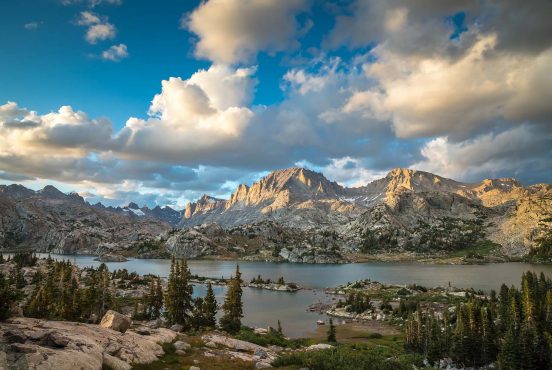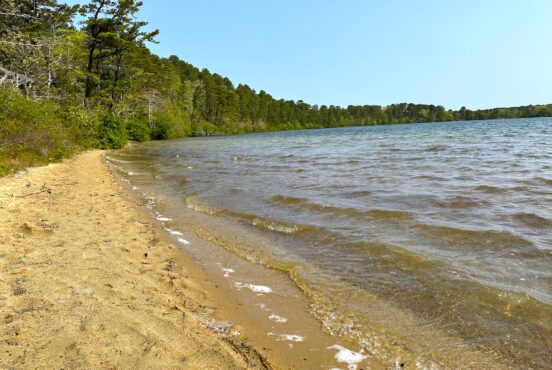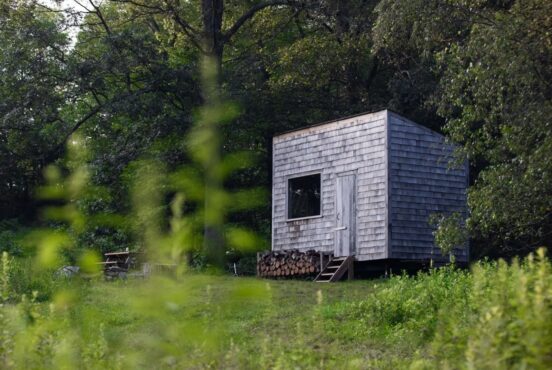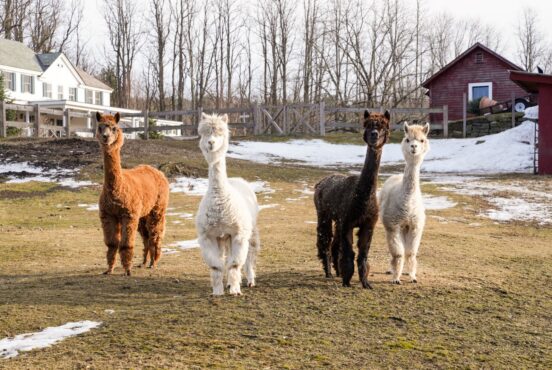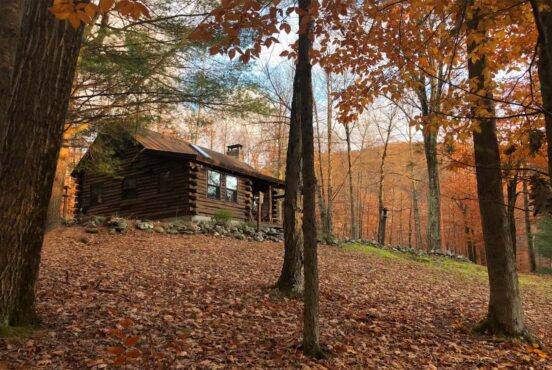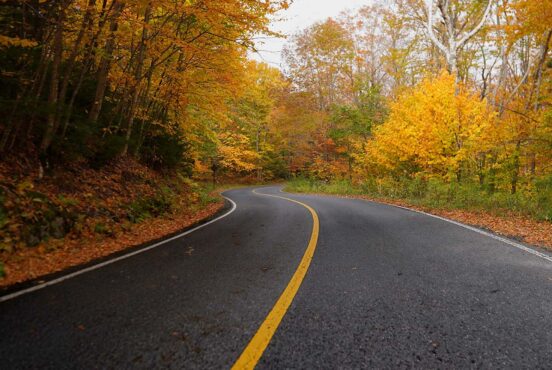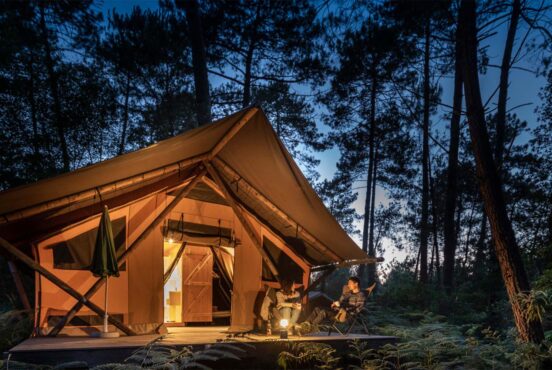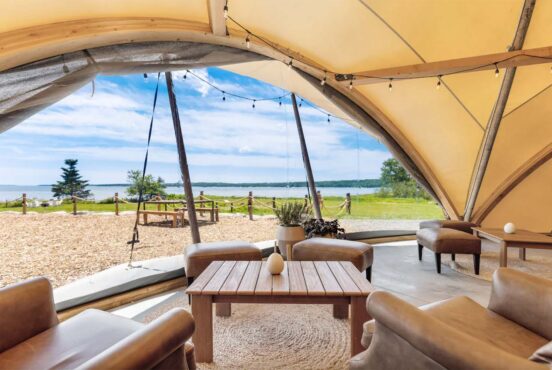Venture into a remote and beautiful section of Western Maine to experience these one-of-a-kind huts all connected by a sprawling network of multi-use trails.
In the heart of Maine’s mountain and lakes region, four off-grid huts are connected by an impressive 80-mile network of groomed trails fit for biking, hiking, nordic skiing, snowshoeing, and fat biking. Yet, it’s the pristine Northwestern Maine backcountry of the Carrabassett Valley that will steal the show.
The valley and surrounding mountain ranges are a wonderland of dense forest, high peaks, wild rivers, and funky outdoor towns that have earned their reputation as adventure hubs. Here, you can hike most of the state’s 4,000-footers, ski one of the largest ski resorts east of the Rockies, and bike spectacular single track almost all year-round. This is the scenic setting of the Maine Huts and Trails, which are perfectly positioned in and around many of the Carrabassett Valley’s best features, more or less creating a semi-circle around the sparkling waters of Flagstaff Lake with the famed Bigelow Range in the backdrop.
Whether you come to enjoy the trails, stay overnight at the Flagstaff or Stratton Brook Hut, or take on a human-powered hut-to-hut trek, it is a worthy outdoor adventure destination you’ll want to return to in every season. Read on for some inspiration and all the details you need to help plan your own hut trip.

What to Expect on a Maine Huts and Trails Adventure
Each off-grid hut is designed to be a basecamp for your outdoor adventures, equipped with hot showers, toilets, a full kitchen, gear drying area, private bunkrooms, and gathering areas. Just as the name implies, the multi-use trails themselves are the cornerstone of the experience — and are worth a visit, regardless of whether or not you spend the night.
To access each hut, you’ll have to hike, bike or ski using the Maine Hut Trail — a clearly marked and wide-open trail that also features ancillary trails for more ways to enjoy rugged, sidecountry terrain on foot or bike. You can hike or bike to a hut and call it a day, or link a few together for a bigger backcountry objective. Whatever you choose, there are some key details about the huts and trails to know before you get out there.
Meet the Four Huts in the Maine Huts and Trails System
Stratton Brook Hut
One of the most popular huts for a day trip, visitors will get a workout hoofing it up 3.3 miles gaining 1900 feet in elevation to the top of the popular Oak Knoll. Steep it may be, but the payoff is sweet, thanks to scenic mountain vistas and a comfy hut with an open outdoor area to kick back and enjoy the view.
For mountain bikers, this is single-track heaven, and hikers can easily link up to other footpaths in the sprawling trail network. The westernmost hut is a great starting place for a hut-to-hut journey (and gets the steeps out of the way) that takes you east to the Poplar Hut in 7.7 miles.
Poplar Hut
The cozy Poplar Hut is the closest hut to downtown Kingfield, a local town in the center of Carrabassett Valley well-known as the region’s main adventure hub.
It’s the only hut that utilizes hydroelectric power, but the nearby brooks, streams, and waterfalls happen to be attractions in their own right for overnight guests and day trippers alike. Use the Airport Trailhead for the shortest route in (3.3 miles) with an 883-foot elevation gain. Continue hiking north to the Flagstaff Hut, which is an 11-mile-long haul. Use the Halfway Yurt as a stopover point to rest and refuel before continuing on to Flagstaff Hut.
Flagstaff Hut

My personal favorite is the lakefront Flagstaff Hut, a rustic ecolodge on the shores of Flagstaff Lake with plenty of opportunities to get out on land and water. With only a 2.2-mile hike in from the trailhead at Long Dam Falls road, it is the most accessible and, in my experience, great for kids.
I’ve both hiked and skied in with my little one in tow, who happily enjoyed the gentle rolling hills that are carved into the hardwood forest on our way to the hut. The lake is a short walk from the hut, where you can paddle, swim, or stroll around the shoreline and take in the views of the Bigelows. Complete your hut sojourn by continuing north for 11.5 miles to the Grand Falls Hut.
Grand Falls Hut
Seclusion and easy river access are two of the biggest draws to the Grand Falls Hut. Hike, bike, or ski using the Maine Hut Trail, or paddle six miles on the Dead River into this remote locale to take advantage of the fishing, rafting, and solitude with a side of mountain views.
As of summer 2024, the Grand Fall Hut is temporarily closed for maintenance and repairs. While we anxiously await its reopening, it’s a good reminder to appreciate our backcountry infrastructure. Huts like Grand Falls require a lot of time, care, and resources to keep them open for everyone to enjoy.
What to Know Before Booking a Stay at the Maine Huts and Trails

It’s important to know the differences between self-service and full-service, along with hut stays and availability in different seasons.
Booking a full-service hut stay will include three full meals cooked by hut staff (including a trail lunch, if preferred!), which is essentially the only differentiating factor between that and a self-service stay. During a self-service stay, hut staff will be onsite for assistance, but you are responsible for bringing in and preparing your own meals in the hut kitchen (that means doing dishes, too!).
Both include hot coffee and tea, potable water, wine, and beer available for purchase, access to the great room, library, private hot showers and bathrooms, lighting, bunk with a foam mattress and pillow, and radiant floor heating during the fall and winter.
Seasonality: When to Visit the Huts
By the middle of May, the huts have recovered from Maine’s harsh winter and any lingering snowmelt has dried up at mud season’s close. At this point, the huts are ready to welcome visitors back to enjoy the warmer months until they close again in mid-October. The multi-use trails are also open and totally free for public use.
Note that for summer 2024, only the Flagstaff Hut is available for self-service, full hut rentals for large groups of around 15-30 people have a two-night minimum. Rates are $1300 for two nights at a single hut during the week and $1500 for weekends.
After a brief hiatus, the huts open once again in mid-December through March and the snow-covered trails are groomed for the winter season. Day trippers are allowed to use the facilities (kitchen, bathroom, common area, etc.) to warm up, and self and full-service stays are available for overnight guests at $140-160 per night, per person for full-service and $90-100 per night, per person for self-service.

What to Pack When Staying at the Maine Huts and Trails
Luckily, you can pack pretty light for an overnight trip to one of the huts, since many amenities are already included. Be prepared to carry all of this in and out, unless you have paid for full-service which includes an optional gear shuttle by the hut staff.
- Backpack
- 40-degree compressible sleeping bag
- Pillowcase
- Lightweight slippers
- Headlamp and/or flashlight
- Water bottle
- Basic first aid kit
- Trail map
- Toiletries
- Towel
- Change of clothes and appropriate seasonal layers
Find Your Next Adventure
Get epic travel ideas delivered to your inbox with Weekend Wanderer, our newsletter inspiring thousands of readers every week.
Seen in: Backpacking, Maine, New England




